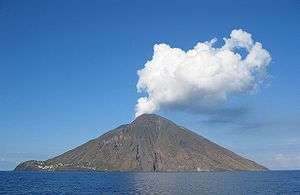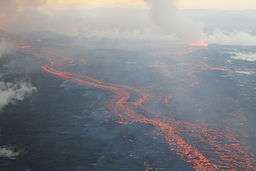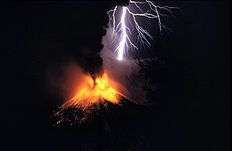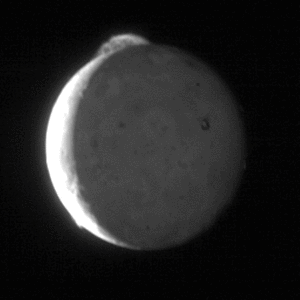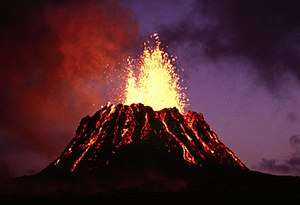Volcano
A volcano is a rupture in the crust of a planetary-mass object, such as Earth, that allows hot lava, volcanic ash, and gases to escape from a magma chamber below the surface.
Earth's volcanoes occur because its crust is broken into 17 major, rigid tectonic plates that float on a hotter, softer layer in its mantle.[1] Therefore, on Earth, volcanoes are generally found where tectonic plates are diverging or converging, and most are found underwater. For example, a mid-oceanic ridge, such as the Mid-Atlantic Ridge, has volcanoes caused by divergent tectonic plates whereas the Pacific Ring of Fire has volcanoes caused by convergent tectonic plates. Volcanoes can also form where there is stretching and thinning of the crust's plates, e.g., in the East African Rift and the Wells Gray-Clearwater volcanic field and Rio Grande Rift in North America. This type of volcanism falls under the umbrella of "plate hypothesis" volcanism.[2] Volcanism away from plate boundaries has also been explained as mantle plumes. These so-called "hotspots", for example Hawaii, are postulated to arise from upwelling diapirs with magma from the core–mantle boundary, 3,000 km deep in the Earth. Volcanoes are usually not created where two tectonic plates slide past one another.
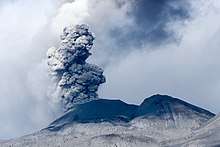
.jpg)
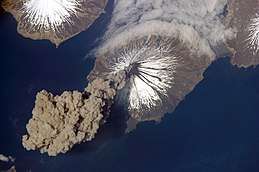
Large eruptions can affect ambient temperature as ash and droplets of sulfuric acid obscure the sun and cool the Earth's troposphere; historically, large volcanic eruptions have been followed by volcanic winters which have caused catastrophic famines.

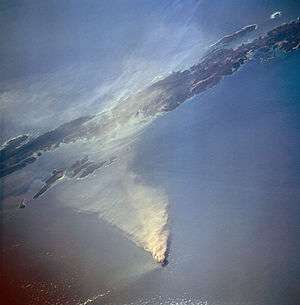
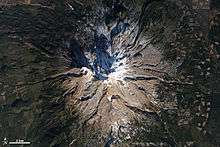
Etymology
The word volcano is derived from the name of Vulcano, a volcanic island in the Aeolian Islands of Italy whose name in turn comes from Vulcan, the god of fire in Roman mythology.[3] The study of volcanoes is called volcanology, sometimes spelled vulcanology.
Plate tectonics
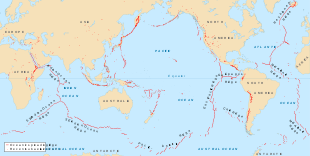
Divergent plate boundaries
At the mid-oceanic ridges, two tectonic plates diverge from one another as new oceanic crust is formed by the cooling and solidifying of hot molten rock. Because the crust is very thin at these ridges due to the pull of the tectonic plates, the release of pressure leads to adiabatic expansion (without transfer of heat or matter) and the partial melting of the mantle, causing volcanism and creating new oceanic crust. Most divergent plate boundaries are at the bottom of the oceans; therefore, most volcanic activity on the Earth is submarine, forming new seafloor. Black smokers (also known as deep sea vents) are evidence of this kind of volcanic activity. Where the mid-oceanic ridge is above sea-level, volcanic islands are formed; for example, Iceland.
Convergent plate boundaries
Subduction zones are places where two plates, usually an oceanic plate and a continental plate, collide. In this case, the oceanic plate subducts, or submerges, under the continental plate, forming a deep ocean trench just offshore. In a process called flux melting, water released from the subducting plate lowers the melting temperature of the overlying mantle wedge, thus creating magma. This magma tends to be extremely viscous because of its high silica content, so it often does not attain the surface but cools and solidifies at depth. When it does reach the surface, however, a volcano is formed. Typical examples are Mount Etna and the volcanoes in the Pacific Ring of Fire.
Hotspots
Hotspots are volcanic areas believed to be formed by mantle plumes, which are hypothesized to be columns of hot material rising from the core-mantle boundary in a fixed space that causes large-volume melting. Because tectonic plates move across them, each volcano becomes dormant and is eventually re-formed as the plate advances over the postulated plume. The Hawaiian Islands are said to have been formed in such a manner; so has the Snake River Plain, with the Yellowstone Caldera being the part of the North American plate above the hot spot. This theory, however, has been doubted.[2]
Volcanic features
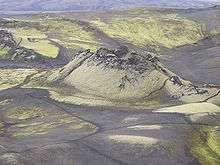
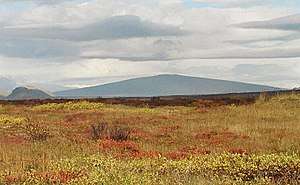
The most common perception of a volcano is of a conical mountain, spewing lava and poisonous gases from a crater at its summit; however, this describes just one of the many types of volcano. The features of volcanoes are much more complicated and their structure and behavior depends on a number of factors. Some volcanoes have rugged peaks formed by lava domes rather than a summit crater while others have landscape features such as massive plateaus. Vents that issue volcanic material (including lava and ash) and gases (mainly steam and magmatic gases) can develop anywhere on the landform and may give rise to smaller cones such as Puʻu ʻŌʻō on a flank of Hawaii's Kīlauea. Other types of volcano include cryovolcanoes (or ice volcanoes), particularly on some moons of Jupiter, Saturn, and Neptune; and mud volcanoes, which are formations often not associated with known magmatic activity. Active mud volcanoes tend to involve temperatures much lower than those of igneous volcanoes except when the mud volcano is actually a vent of an igneous volcano.
Fissure vents
Volcanic fissure vents are flat, linear fractures through which lava emerges.
Shield volcanoes
Shield volcanoes, so named for their broad, shield-like profiles, are formed by the eruption of low-viscosity lava that can flow a great distance from a vent. They generally do not explode catastrophically. Since low-viscosity magma is typically low in silica, shield volcanoes are more common in oceanic than continental settings. The Hawaiian volcanic chain is a series of shield cones, and they are common in Iceland, as well.
Lava domes
Lava domes are built by slow eruptions of highly viscous lava. They are sometimes formed within the crater of a previous volcanic eruption, as in the case of Mount Saint Helens, but can also form independently, as in the case of Lassen Peak. Like stratovolcanoes, they can produce violent, explosive eruptions, but their lava generally does not flow far from the originating vent.
Cryptodomes
Cryptodomes are formed when viscous lava is forced upward causing the surface to bulge. The 1980 eruption of Mount St. Helens was an example; lava beneath the surface of the mountain created an upward bulge which slid down the north side of the mountain.
Volcanic cones (cinder cones)
Volcanic cones or cinder cones result from eruptions of mostly small pieces of scoria and pyroclastics (both resemble cinders, hence the name of this volcano type) that build up around the vent. These can be relatively short-lived eruptions that produce a cone-shaped hill perhaps 30 to 400 meters high. Most cinder cones erupt only once. Cinder cones may form as flank vents on larger volcanoes, or occur on their own. Parícutin in Mexico and Sunset Crater in Arizona are examples of cinder cones. In New Mexico, Caja del Rio is a volcanic field of over 60 cinder cones.
Based on satellite images it was suggested that cinder cones might occur on other terrestrial bodies in the Solar system too; on the surface of Mars and the Moon.[4][5][6][7]
Stratovolcanoes (composite volcanoes)
- Large magma chamber
- Bedrock
- Conduit (pipe)
- Base
- Sill
- Dike
- Layers of ash emitted by the volcano
- Flank
- Layers of lava emitted by the volcano
- Throat
- Parasitic cone
- Lava flow
- Vent
- Crater
- Ash cloud
Stratovolcanoes or composite volcanoes are tall conical mountains composed of lava flows and other ejecta in alternate layers, the strata that gives rise to the name. Stratovolcanoes are also known as composite volcanoes because they are created from multiple structures during different kinds of eruptions. Strato/composite volcanoes are made of cinders, ash, and lava. Cinders and ash pile on top of each other, lava flows on top of the ash, where it cools and hardens, and then the process repeats. Classic examples include Mount Fuji in Japan, Mayon Volcano in the Philippines, and Mount Vesuvius and Stromboli in Italy.
Throughout recorded history, ash produced by the explosive eruption of stratovolcanoes has posed the greatest volcanic hazard to civilizations. Not only do stratovolcanoes have greater pressure buildup from the underlying lava flow than shield volcanoes, but their fissure vents and monogenetic volcanic fields (volcanic cones) also have more powerful eruptions because they are often under extension. They are also steeper than shield volcanoes, with slopes of 30–35° compared to slopes of generally 5–10°, and their loose tephra are material for dangerous lahars.[8] Large pieces of tephra are called volcanic bombs. Big bombs can measure more than 4 feet(1.2 meters) across and weigh several tons.[9]
Supervolcanoes
A supervolcano usually has a large caldera and can produce devastation on an enormous, sometimes continental, scale. Such volcanoes are able to severely cool global temperatures for many years after the eruption due to the huge volumes of sulfur and ash released into the atmosphere. They are the most dangerous type of volcano. Examples include Yellowstone Caldera in Yellowstone National Park and Valles Caldera in New Mexico (both western United States); Lake Taupo in New Zealand; Lake Toba in Sumatra, Indonesia; and Ngorongoro Crater in Tanzania. Because of the enormous area they may cover, supervolcanoes are hard to identify centuries after an eruption. Similarly, large igneous provinces are also considered supervolcanoes because of the vast amount of basalt lava erupted (even though the lava flow is non-explosive).
Underwater volcanoes
Submarine volcanoes are common features of the ocean floor. In shallow water, active volcanoes disclose their presence by blasting steam and rocky debris high above the ocean's surface. In the ocean's deep, the tremendous weight of the water above prevents the explosive release of steam and gases; however, they can be detected by hydrophones and discoloration of water because of volcanic gases. Pillow lava is a common eruptive product of submarine volcanoes and is characterized by thick sequences of discontinuous pillow-shaped masses which form under water. Even large submarine eruptions may not disturb the ocean surface due to the rapid cooling effect and increased buoyancy of water (as compared to air) which often causes volcanic vents to form steep pillars on the ocean floor. Hydrothermal vents are common near these volcanoes, and some support peculiar ecosystems based on dissolved minerals. Over time, the formations created by submarine volcanoes may become so large that they break the ocean surface as new islands or floating pumice rafts.
In 2018, a multitude of seismic signals were detected by earthquake monitoring agencies all over the world in May and June. They created a weird humming sound and some of the signals detected in November of that year had a duration of up to 20 minutes. An oceanographic campaign in May 2019 showed that the previously mysterious humming noises were caused by the formation of an underwater volcano off the coast of Mayotte.[10]
Subglacial volcanoes
Subglacial volcanoes develop underneath icecaps. They are made up of flat lava which flows at the top of extensive pillow lavas and palagonite. When the icecap melts, the lava on top collapses, leaving a flat-topped mountain. These volcanoes are also called table mountains, tuyas, or (uncommonly) mobergs. Very good examples of this type of volcano can be seen in Iceland, however, there are also tuyas in British Columbia. The origin of the term comes from Tuya Butte, which is one of the several tuyas in the area of the Tuya River and Tuya Range in northern British Columbia. Tuya Butte was the first such landform analyzed and so its name has entered the geological literature for this kind of volcanic formation. The Tuya Mountains Provincial Park was recently established to protect this unusual landscape, which lies north of Tuya Lake and south of the Jennings River near the boundary with the Yukon Territory.
Mud volcanoes
Mud volcanoes or mud domes are formations created by geo-excreted liquids and gases, although there are several processes which may cause such activity. The largest structures are 10 kilometers in diameter and reach 700 meters high.
Erupted material
Lava composition
Another way of classifying volcanoes is by the composition of material erupted (lava), since this affects the shape of the volcano. Lava can be broadly classified into four different compositions:[11]
- If the erupted magma contains a high percentage (>63%) of silica, the lava is called felsic.
- Felsic lavas (dacites or rhyolites) tend to be highly viscous (not very fluid) and are erupted as domes or short, stubby flows. Viscous lavas tend to form stratovolcanoes or lava domes. Lassen Peak in California is an example of a volcano formed from felsic lava and is actually a large lava dome.
- Because siliceous magmas are so viscous, they tend to trap volatiles (gases) that are present, which cause the magma to erupt catastrophically, eventually forming stratovolcanoes. Pyroclastic flows (ignimbrites) are highly hazardous products of such volcanoes, since they are composed of molten volcanic ash too heavy to go up into the atmosphere, so they hug the volcano's slopes and travel far from their vents during large eruptions. Temperatures as high as 1,200 °C are known to occur in pyroclastic flows, which will incinerate everything flammable in their path and thick layers of hot pyroclastic flow deposits can be laid down, often up to many meters thick. Alaska's Valley of Ten Thousand Smokes, formed by the eruption of Novarupta near Katmai in 1912, is an example of a thick pyroclastic flow or ignimbrite deposit. Volcanic ash that is light enough to be erupted high into the Earth's atmosphere may travel many kilometres before it falls back to ground as a tuff.
- If the erupted magma contains 52–63% silica, the lava is of intermediate composition.
- These "andesitic" volcanoes generally only occur above subduction zones (e.g. Mount Merapi in Indonesia).
- Andesitic lava is typically formed at convergent boundary margins of tectonic plates, by several processes:
- Hydration melting of peridotite and fractional crystallization
- Melting of subducted slab containing sediments
- Magma mixing between felsic rhyolitic and mafic basaltic magmas in an intermediate reservoir prior to emplacement or lava flow.
- If the erupted magma contains <52% and >45% silica, the lava is called mafic (because it contains higher percentages of magnesium (Mg) and iron (Fe)) or basaltic. These lavas are usually much less viscous than rhyolitic lavas, depending on their eruption temperature; they also tend to be hotter than felsic lavas. Mafic lavas occur in a wide range of settings:
- At mid-ocean ridges, where two oceanic plates are pulling apart, basaltic lava erupts as pillows to fill the gap;
- Shield volcanoes (e.g. the Hawaiian Islands, including Mauna Loa and Kilauea), on both oceanic and continental crust;
- As continental flood basalts.
- Some erupted magmas contain <=45% silica and produce ultramafic lava. Ultramafic flows, also known as komatiites, are very rare; indeed, very few have been erupted at the Earth's surface since the Proterozoic, when the planet's heat flow was higher. They are (or were) the hottest lavas, and probably more fluid than common mafic lavas.
Lava texture
Two types of lava are named according to the surface texture: ʻAʻa (pronounced [ˈʔaʔa]) and pāhoehoe ([paːˈho.eˈho.e]), both Hawaiian words. ʻAʻa is characterized by a rough, clinkery surface and is the typical texture of viscous lava flows. However, even basaltic or mafic flows can be erupted as ʻaʻa flows, particularly if the eruption rate is high and the slope is steep.
Pāhoehoe is characterized by its smooth and often ropey or wrinkly surface and is generally formed from more fluid lava flows. Usually, only mafic flows will erupt as pāhoehoe, since they often erupt at higher temperatures or have the proper chemical make-up to allow them to flow with greater fluidity.
Volcanic activity
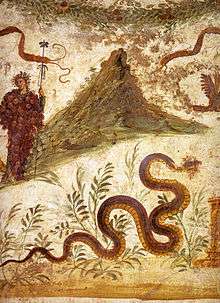
Popular classification of volcanoes
A popular way of classifying magmatic volcanoes is by their frequency of eruption, with those that erupt regularly called active, those that have erupted in historical times but are now quiet called dormant or inactive, and those that have not erupted in historical times called extinct. However, these popular classifications—extinct in particular—are practically meaningless to scientists. They use classifications which refer to a particular volcano's formative and eruptive processes and resulting shapes.
Active
There is no consensus among volcanologists on how to define an "active" volcano. The lifespan of a volcano can vary from months to several million years, making such a distinction sometimes meaningless when compared to the lifespans of humans or even civilizations. For example, many of Earth's volcanoes have erupted dozens of times in the past few thousand years but are not currently showing signs of eruption. Given the long lifespan of such volcanoes, they are very active. By human lifespans, however, they are not.
Scientists usually consider a volcano to be erupting or likely to erupt if it is currently erupting, or showing signs of unrest such as unusual earthquake activity or significant new gas emissions. Most scientists consider a volcano active if it has erupted in the last 10,000 years (Holocene times)—the Smithsonian Global Volcanism Program uses this definition of active. Most volcanoes are situated on the Pacific Ring of Fire.[12] An estimated 500 million people live near active volcanoes.[12]
Historical time (or recorded history) is another timeframe for active.[13][14] The Catalogue of the Active Volcanoes of the World, published by the International Association of Volcanology, uses this definition, by which there are more than 500 active volcanoes.[13] However, the span of recorded history differs from region to region. In China and the Mediterranean, it reaches back nearly 3,000 years, but in the Pacific Northwest of the United States and Canada, it reaches back less than 300 years, and in Hawaii and New Zealand, only around 200 years.[13]
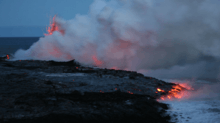
As of 2013, the following are considered Earth's most active volcanoes:[15]
- Kīlauea, the famous Hawaiian volcano, was in nearly continuous, effusive eruption (in which lava steadily flows onto the ground) between 1983 through 2018, and had the longest-observed lava lake.
- Mount Etna and nearby Stromboli, two Mediterranean volcanoes in "almost continuous eruption" since antiquity.
- Piton de la Fournaise, in Réunion, erupts frequently enough to be a tourist attraction.
As of 2010, the longest ongoing (but not necessarily continuous) volcanic eruptive phases are:[16]
- Mount Yasur, 111 years
- Mount Etna, 109 years
- Stromboli, 108 years
- Santa María, 101 years
- Sangay, 94 years
Other very active volcanoes include:
- Mount Nyiragongo and its neighbor, Nyamuragira, are Africa's most active volcanoes.
 Nyiragongo's lava lake
Nyiragongo's lava lake - Erta Ale, in the Afar Triangle, has maintained a lava lake since at least 1906.
- Mount Erebus, in Antarctica, has maintained a lava lake since at least 1972.
- Mount Merapi
- Whakaari / White Island, has been in a continuous state of releasing volcanic gas since before European observation in 1769.
- Ol Doinyo Lengai
- Ambrym
- Arenal Volcano
- Pacaya
- Klyuchevskaya Sopka
- Sheveluch
Extinct
Extinct volcanoes are those that scientists consider unlikely to erupt again because the volcano no longer has a magma supply. Examples of extinct volcanoes are many volcanoes on the Hawaiian – Emperor seamount chain in the Pacific Ocean (although some volcanoes at the eastern end of the chain are active), Hohentwiel in Germany, Shiprock in New Mexico, Zuidwal volcano in the Netherlands and many volcanoes in Italy like Monte Vulture. Edinburgh Castle in Scotland is famously located atop an extinct volcano. Otherwise, whether a volcano is truly extinct is often difficult to determine. Since "supervolcano" calderas can have eruptive lifespans sometimes measured in millions of years, a caldera that has not produced an eruption in tens of thousands of years is likely to be considered dormant instead of extinct. Some volcanologists refer to extinct volcanoes as inactive, though the term is now more commonly used for dormant volcanoes once thought to be extinct.
Dormant and reactivated
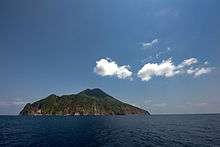
It is difficult to distinguish an extinct volcano from a dormant (inactive) one. Dormant volcanoes are those that have not erupted for thousands of years, but are likely to erupt again in the future.[17][18] Volcanoes are often considered to be extinct if there are no written records of its activity. Nevertheless, volcanoes may remain dormant for a long period of time. For example, Yellowstone has a repose/recharge period of around 700,000 years, and Toba of around 380,000 years.[19] Vesuvius was described by Roman writers as having been covered with gardens and vineyards before its eruption of 79 CE, which destroyed the towns of Herculaneum and Pompeii. Before its catastrophic eruption of 1991, Pinatubo was an inconspicuous volcano, unknown to most people in the surrounding areas. Two other examples are the long-dormant Soufrière Hills volcano on the island of Montserrat, thought to be extinct before activity resumed in 1995, and Fourpeaked Mountain in Alaska, which, before its September 2006 eruption, had not erupted since before 8000 BCE and had long been thought to be extinct.
Technical classification of volcanoes
Volcanic-alert level
The three common popular classifications of volcanoes can be subjective and some volcanoes thought to have been extinct have erupted again. To help prevent people from falsely believing they are not at risk when living on or near a volcano, countries have adopted new classifications to describe the various levels and stages of volcanic activity.[20] Some alert systems use different numbers or colors to designate the different stages. Other systems use colors and words. Some systems use a combination of both.
Volcano warning schemes of the United States
The United States Geological Survey (USGS) has adopted a common system nationwide for characterizing the level of unrest and eruptive activity at volcanoes. The new volcano alert-level system classifies volcanoes now as being in a normal, advisory, watch or warning stage. Additionally, colors are used to denote the amount of ash produced.
Decade volcanoes
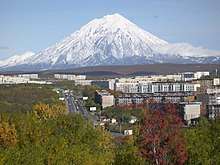
The Decade Volcanoes are 16 volcanoes identified by the International Association of Volcanology and Chemistry of the Earth's Interior (IAVCEI) as being worthy of particular study in light of their history of large, destructive eruptions and proximity to populated areas. They are named Decade Volcanoes because the project was initiated as part of the United Nations-sponsored International Decade for Natural Disaster Reduction (the 1990s). The 16 current Decade Volcanoes are
- Avachinsky-Koryaksky (grouped together), Kamchatka, Russia
- Nevado de Colima, Jalisco and Colima, Mexico
- Mount Etna, Sicily, Italy
- Galeras, Nariño, Colombia
- Mauna Loa, Hawaii, US
- Mount Merapi, Central Java, Indonesia
- Mount Nyiragongo, Democratic Republic of the Congo
- Mount Rainier, Washington, US
- Sakurajima, Kagoshima Prefecture, Japan
- Santa Maria/Santiaguito, Guatemala
- Santorini, Cyclades, Greece
- Taal Volcano, Luzon, Philippines
- Teide, Canary Islands, Spain
- Ulawun, New Britain, Papua New Guinea
- Mount Unzen, Nagasaki Prefecture, Japan
- Vesuvius, Naples, Italy
The Deep Earth Carbon Degassing Project, an initiative of the Deep Carbon Observatory, monitors nine volcanoes, two of which are Decade volcanoes. The focus of the Deep Earth Carbon Degassing Project is to use Multi-Component Gas Analyzer System instruments to measure CO2/SO2 ratios in real-time and in high-resolution to allow detection of the pre-eruptive degassing of rising magmas, improving prediction of volcanic activity.[21]
Effects of volcanoes
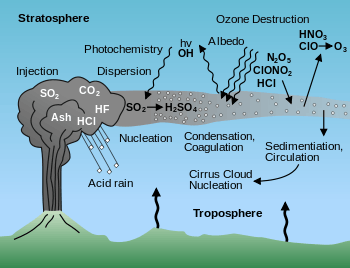
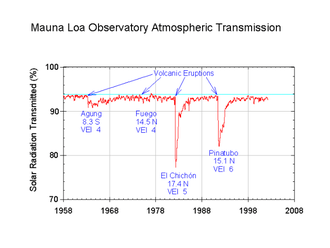
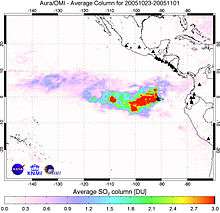
There are many different types of volcanic eruptions and associated activity: phreatic eruptions (steam-generated eruptions), explosive eruption of high-silica lava (e.g., rhyolite), effusive eruption of low-silica lava (e.g., basalt), pyroclastic flows, lahars (debris flow) and carbon dioxide emission. All of these activities can pose a hazard to humans. Earthquakes, hot springs, fumaroles, mud pots and geysers often accompany volcanic activity.
Volcanic gases
The concentrations of different volcanic gases can vary considerably from one volcano to the next. Water vapor is typically the most abundant volcanic gas, followed by carbon dioxide[22] and sulfur dioxide. Other principal volcanic gases include hydrogen sulfide, hydrogen chloride, and hydrogen fluoride. A large number of minor and trace gases are also found in volcanic emissions, for example hydrogen, carbon monoxide, halocarbons, organic compounds, and volatile metal chlorides.
Large, explosive volcanic eruptions inject water vapor (H2O), carbon dioxide (CO2), sulfur dioxide (SO2), hydrogen chloride (HCl), hydrogen fluoride (HF) and ash (pulverized rock and pumice) into the stratosphere to heights of 16–32 kilometres (10–20 mi) above the Earth's surface. The most significant impacts from these injections come from the conversion of sulfur dioxide to sulfuric acid (H2SO4), which condenses rapidly in the stratosphere to form fine sulfate aerosols. The SO2 emissions alone of two different eruptions are sufficient to compare their potential climatic impact.[23] The aerosols increase the Earth's albedo—its reflection of radiation from the Sun back into space—and thus cool the Earth's lower atmosphere or troposphere; however, they also absorb heat radiated up from the Earth, thereby warming the stratosphere. Several eruptions during the past century have caused a decline in the average temperature at the Earth's surface of up to half a degree (Fahrenheit scale) for periods of one to three years; sulfur dioxide from the eruption of Huaynaputina probably caused the Russian famine of 1601–1603.[24]
Significant consequences
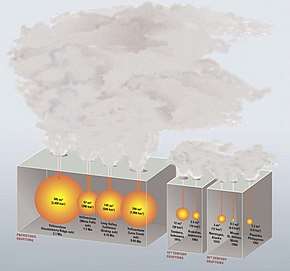
Prehistory
A volcanic winter is thought to have taken place around 70,000 years ago after the supereruption of Lake Toba on Sumatra island in Indonesia.[25] According to the Toba catastrophe theory to which some anthropologists and archeologists subscribe, it had global consequences,[26] killing most humans then alive and creating a population bottleneck that affected the genetic inheritance of all humans today.[27]
It has been suggested that volcanic activity caused or contributed to the End-Ordovician, Permian-Triassic, Late Devonian mass extinctions, and possibly others. The massive eruptive event which formed the Siberian Traps, one of the largest known volcanic events of the last 500 million years of Earth's geological history, continued for a million years and is considered to be the likely cause of the "Great Dying" about 250 million years ago,[28] which is estimated to have killed 90% of species existing at the time.[29]
Historical
The 1815 eruption of Mount Tambora created global climate anomalies that became known as the "Year Without a Summer" because of the effect on North American and European weather.[30] Agricultural crops failed and livestock died in much of the Northern Hemisphere, resulting in one of the worst famines of the 19th century.[31]
The freezing winter of 1740–41, which led to widespread famine in northern Europe, may also owe its origins to a volcanic eruption.[32]
Acid rain
Sulfate aerosols promote complex chemical reactions on their surfaces that alter chlorine and nitrogen chemical species in the stratosphere. This effect, together with increased stratospheric chlorine levels from chlorofluorocarbon pollution, generates chlorine monoxide (ClO), which destroys ozone (O3). As the aerosols grow and coagulate, they settle down into the upper troposphere where they serve as nuclei for cirrus clouds and further modify the Earth's radiation balance. Most of the hydrogen chloride (HCl) and hydrogen fluoride (HF) are dissolved in water droplets in the eruption cloud and quickly fall to the ground as acid rain. The injected ash also falls rapidly from the stratosphere; most of it is removed within several days to a few weeks. Finally, explosive volcanic eruptions release the greenhouse gas carbon dioxide and thus provide a deep source of carbon for biogeochemical cycles.[33]
Gas emissions from volcanoes are a natural contributor to acid rain. Volcanic activity releases about 130 to 230 teragrams (145 million to 255 million short tons) of carbon dioxide each year.[34] Volcanic eruptions may inject aerosols into the Earth's atmosphere. Large injections may cause visual effects such as unusually colorful sunsets and affect global climate mainly by cooling it. Volcanic eruptions also provide the benefit of adding nutrients to soil through the weathering process of volcanic rocks. These fertile soils assist the growth of plants and various crops. Volcanic eruptions can also create new islands, as the magma cools and solidifies upon contact with the water.
Hazards
Ash thrown into the air by eruptions can present a hazard to aircraft, especially jet aircraft where the particles can be melted by the high operating temperature; the melted particles then adhere to the turbine blades and alter their shape, disrupting the operation of the turbine. Dangerous encounters in 1982 after the eruption of Galunggung in Indonesia, and 1989 after the eruption of Mount Redoubt in Alaska raised awareness of this phenomenon. Nine Volcanic Ash Advisory Centers were established by the International Civil Aviation Organization to monitor ash clouds and advise pilots accordingly. The 2010 eruptions of Eyjafjallajökull caused major disruptions to air travel in Europe.
Volcanoes on other celestial bodies
The Earth's Moon has no large volcanoes and no current volcanic activity, although recent evidence suggests it may still possess a partially molten core.[35] However, the Moon does have many volcanic features such as maria (the darker patches seen on the moon), rilles and domes.
The planet Venus has a surface that is 90% basalt, indicating that volcanism played a major role in shaping its surface. The planet may have had a major global resurfacing event about 500 million years ago,[36] from what scientists can tell from the density of impact craters on the surface. Lava flows are widespread and forms of volcanism not present on Earth occur as well. Changes in the planet's atmosphere and observations of lightning have been attributed to ongoing volcanic eruptions, although there is no confirmation of whether or not Venus is still volcanically active. However, radar sounding by the Magellan probe revealed evidence for comparatively recent volcanic activity at Venus's highest volcano Maat Mons, in the form of ash flows near the summit and on the northern flank.
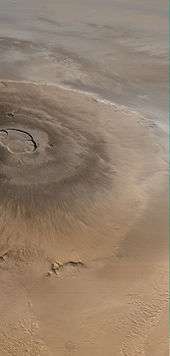
There are several extinct volcanoes on Mars, four of which are vast shield volcanoes far bigger than any on Earth. They include Arsia Mons, Ascraeus Mons, Hecates Tholus, Olympus Mons, and Pavonis Mons. These volcanoes have been extinct for many millions of years,[37] but the European Mars Express spacecraft has found evidence that volcanic activity may have occurred on Mars in the recent past as well.[37]
Jupiter's moon Io is the most volcanically active object in the solar system because of tidal interaction with Jupiter. It is covered with volcanoes that erupt sulfur, sulfur dioxide and silicate rock, and as a result, Io is constantly being resurfaced. Its lavas are the hottest known anywhere in the solar system, with temperatures exceeding 1,800 K (1,500 °C). In February 2001, the largest recorded volcanic eruptions in the solar system occurred on Io.[38] Europa, the smallest of Jupiter's Galilean moons, also appears to have an active volcanic system, except that its volcanic activity is entirely in the form of water, which freezes into ice on the frigid surface. This process is known as cryovolcanism, and is apparently most common on the moons of the outer planets of the solar system.
In 1989, the Voyager 2 spacecraft observed cryovolcanoes (ice volcanoes) on Triton, a moon of Neptune, and in 2005 the Cassini–Huygens probe photographed fountains of frozen particles erupting from Enceladus, a moon of Saturn.[39][40] The ejecta may be composed of water, liquid nitrogen, ammonia, dust, or methane compounds. Cassini–Huygens also found evidence of a methane-spewing cryovolcano on the Saturnian moon Titan, which is believed to be a significant source of the methane found in its atmosphere.[41] It is theorized that cryovolcanism may also be present on the Kuiper Belt Object Quaoar.
A 2010 study of the exoplanet COROT-7b, which was detected by transit in 2009, suggested that tidal heating from the host star very close to the planet and neighboring planets could generate intense volcanic activity similar to that found on Io.[42]
Traditional beliefs about volcanoes
Many ancient accounts ascribe volcanic eruptions to supernatural causes, such as the actions of gods or demigods. To the ancient Greeks, volcanoes' capricious power could only be explained as acts of the gods, while 16th/17th-century German astronomer Johannes Kepler believed they were ducts for the Earth's tears.[43] One early idea counter to this was proposed by Jesuit Athanasius Kircher (1602–1680), who witnessed eruptions of Mount Etna and Stromboli, then visited the crater of Vesuvius and published his view of an Earth with a central fire connected to numerous others caused by the burning of sulfur, bitumen and coal.
Various explanations were proposed for volcano behavior before the modern understanding of the Earth's mantle structure as a semisolid material was developed. For decades after awareness that compression and radioactive materials may be heat sources, their contributions were specifically discounted. Volcanic action was often attributed to chemical reactions and a thin layer of molten rock near the surface.
See also
- Global Volcanism Program – American research program
- List of extraterrestrial volcanoes
- Maritime impacts of volcanic eruptions
- Prediction of volcanic activity
- Timeline of volcanism on Earth
- Volcanic Explosivity Index – qualitative scale indicating the explosive intensity of volcanic eruptions
- Volcano Number
- Volcano observatory
References
- NSTA Press / Archive.Org (2007). "Earthquakes, Volcanoes, and Tsunamis" (PDF). Resources for Environmental Literacy. Archived from the original (PDF) on September 13, 2012. Retrieved April 22, 2014.
- Foulger, Gillian R. (2010). Plates vs. Plumes: A Geological Controversy. Wiley-Blackwell. ISBN 978-1-4051-6148-0.
- Young, Davis A. (January 2016). "Volcano". Mind over Magma: The Story of Igneous Petrology. Archived from the original on November 12, 2015. Retrieved January 11, 2016.
- Wood, C.A. (1979). "Cindercones on Earth, Moon and Mars". Lunar and Planetary Science. X: 1370–1372. Bibcode:1979LPI....10.1370W.
- Meresse, S.; Costard, F.O.; Mangold, N.; Masson, P.; Neukum, G. (2008). "Formation and evolution of the chaotic terrains by subsidence and magmatism: Hydraotes Chaos, Mars". Icarus. 194 (2): 487. Bibcode:2008Icar..194..487M. doi:10.1016/j.icarus.2007.10.023.
- Brož, P.; Hauber, E. (2012). "A unique volcanic field in Tharsis, Mars: Pyroclastic cones as evidence for explosive eruptions". Icarus. 218 (1): 88. Bibcode:2012Icar..218...88B. doi:10.1016/j.icarus.2011.11.030.
- Lawrence, S.J.; Stopar, J.D.; Hawke, B.R.; Greenhagen, B.T.; Cahill, J.T.S.; Bandfield, J.L.; Jolliff, B.L.; Denevi, B.W.; Robinson, M.S.; Glotch, T.D.; Bussey, D.B.J.; Spudis, P.D.; Giguere, T.A.; Garry, W.B. (2013). "LRO observations of morphology and surface roughness of volcanic cones and lobate lava flows in the Marius Hills". Journal of Geophysical Research: Planets. 118 (4): 615. Bibcode:2013JGRE..118..615L. doi:10.1002/jgre.20060.
- Lockwood, John P.; Hazlett, Richard W. (2010). Volcanoes: Global Perspectives. p. 552. ISBN 978-1-4051-6250-0.
- Berger, Melvin, Gilda Berger, and Higgins Bond. "Volcanoes-why and how ." Why do volcanoes blow their tops?: Questions and answers about volcanoes and earthquakes. New York: Scholastic, 1999. 7. Print.
- Ashley Strickland (January 10, 2020). "Origin of mystery humming noises heard around the world, uncovered". CNN.
- Casq, R.A.F.; Wright, J.V. (1987). Volcanic Successions. Unwin Hyman Inc. p. 528. ISBN 978-0-04-552022-0.
- "Volcanoes". European Space Agency. 2009. Retrieved August 16, 2012.
- Decker, Robert Wayne; Decker, Barbara (1991). Mountains of Fire: The Nature of Volcanoes. Cambridge University Press. p. 7. ISBN 978-0-521-31290-5.
- Tilling, Robert I. (1997). "Volcano environments". Volcanoes. Denver, Colorado: U.S. Department of the Interior, U.S. Geological Survey. Retrieved August 16, 2012.
There are more than 500 active volcanoes (those that have erupted at least once within recorded history) in the world
- "The most active volcanoes in the world". VolcanoDiscovery.com. Retrieved August 3, 2013.
- "The World's Five Most Active Volcanoes". livescience.com. Retrieved August 4, 2013.
- Nelson, Stephen A. (October 4, 2016). "Volcanic Hazards & Prediction of Volcanic Eruptions". Tulane University. Retrieved September 5, 2018.
- "How is a volcano defined as being active, dormant, or extinct?". Volcano World. Oregon State University. Retrieved September 5, 2018.
- Chesner, C.A.; Rose, J.A.; Deino, W.I.; Drake, R.; Westgate, A. (March 1991). "Eruptive History of Earth's Largest Quaternary caldera (Toba, Indonesia) Clarified" (PDF). Geology. 19 (3): 200–203. Bibcode:1991Geo....19..200C. doi:10.1130/0091-7613(1991)019<0200:EHOESL>2.3.CO;2. Retrieved January 20, 2010.
- "Volcanic Alert Levels of Various Countries". Volcanolive.com. Retrieved August 22, 2011.
- Aiuppa, Alessandro; Moretti, Roberto; Federico, Cinzia; Giudice, Gaetano; Gurrieri, Sergio; Liuzzo, Marco; Papale, Paolo; Shinohara, Hiroshi; Valenza, Mariano (2007). "Forecasting Etna eruptions by real-time observation of volcanic gas composition". Geology. 35 (12): 1115–1118. Bibcode:2007Geo....35.1115A. doi:10.1130/G24149A.1.
- Pedone, M.; Aiuppa, A.; Giudice, G.; Grassa, F.; Francofonte, V.; Bergsson, B.; Ilyinskaya, E. (2014). "Tunable diode laser measurements of hydrothermal/volcanic CO2 and implications for the global CO2 budget". Solid Earth. 5 (2): 1209–1221. Bibcode:2014SolE....5.1209P. doi:10.5194/se-5-1209-2014.
- Miles, M.G.; Grainger, R.G.; Highwood, E.J. (2004). "The significance of volcanic eruption strength and frequency for climate" (PDF). Quarterly Journal of the Royal Meteorological Society. 130 (602): 2361–2376. Bibcode:2004QJRMS.130.2361M. doi:10.1256/qj.03.60.
- University of California – Davis (April 25, 2008). "Volcanic Eruption Of 1600 Caused Global Disruption". ScienceDaily.
- "Supervolcano eruption – in Sumatra – deforested India 73,000 years ago". ScienceDaily. November 24, 2009.
- "The new batch – 150,000 years ago". BBC. Archived from the original on March 26, 2006.
- "When humans faced extinction". BBC. June 9, 2003. Retrieved January 5, 2007.
- O'Hanlon, Larry (March 14, 2005). "Yellowstone's Super Sister". Discovery Channel. Archived from the original on March 14, 2005.
- Benton, Michael J. (2005). When Life Nearly Died: The Greatest Mass Extinction of All Time. Thames & Hudson. ISBN 978-0-500-28573-2.
- Volcanoes in human history: the far-reaching effects of major eruptions. Jelle Zeilinga de Boer, Donald Theodore Sanders (2002). Princeton University Press. p. 155. ISBN 0-691-05081-3
- Oppenheimer, Clive (2003). "Climatic, environmental and human consequences of the largest known historic eruption: Tambora volcano (Indonesia) 1815". Progress in Physical Geography. 27 (2): 230–259. doi:10.1191/0309133303pp379ra.
- Ó Gráda, Cormac (February 6, 2009). "Famine: A Short History". Princeton University Press. Archived from the original on January 12, 2016.
- McGee, Kenneth A.; Doukas, Michael P.; Kessler, Richard; Gerlach, Terrence M. (May 1997). "Impacts of Volcanic Gases on Climate, the Environment, and People". United States Geological Survey. Retrieved August 9, 2014.

- "Volcanic Gases and Their Effects". U.S. Geological Survey. Retrieved June 16, 2007.
- Wieczorek, Mark A.; Jolliff, Bradley L.; Khan, Amir; Pritchard, Matthew E.; Weiss, Benjamin P.; Williams, James G.; Hood, Lon L.; Righter, Kevin; Neal, Clive R.; Shearer, Charles K.; McCallum, I. Stewart; Tompkins, Stephanie; Hawke, B. Ray; Peterson, Chris; Gillis, Jeffrey J.; Bussey, Ben (January 1, 2006). "The constitution and structure of the lunar interior". Reviews in Mineralogy and Geochemistry. 60 (1): 221–364. Bibcode:2006RvMG...60..221W. doi:10.2138/rmg.2006.60.3.
- Bindschadler, D.L. (1995). "Magellan: A new view of Venus' geology and geophysics". Reviews of Geophysics. 33 (S1): 459. Bibcode:1995RvGeo..33S.459B. doi:10.1029/95RG00281.
- "Glacial, volcanic and fluvial activity on Mars: latest images". European Space Agency. February 25, 2005. Retrieved August 17, 2006.
- "Exceptionally bright eruption on Io rivals largest in solar system". W.M. Keck Observatory. November 13, 2002.
- "Cassini Finds an Atmosphere on Saturn's Moon Enceladus". PPARC. March 16, 2005. Archived from the original on March 10, 2007. Retrieved July 4, 2014.
- Smith, Yvette (March 15, 2012). "Enceladus, Saturn's Moon". Image of the Day Gallery. NASA. Retrieved July 4, 2014.
- "Hydrocarbon volcano discovered on Titan". Newscientist.com. June 8, 2005. Retrieved October 24, 2010.
- Jaggard, Victoria (February 5, 2010). ""Super Earth" May Really Be New Planet Type: Super-Io". National Geographic web site daily news. National Geographic Society. Retrieved March 11, 2010.
- Williams, Micheal (November 2007). "Hearts of fire". Morning Calm (11–2007): 6.
Further reading
- Macdonald, Gordon; Abbott, Agatin (1970). Volcanoes in the Sea: The Geology of Hawaii. University of Hawaii Press. ISBN 978-0-870-22495-9.
- Marti, Joan & Ernst, Gerald. (2005). Volcanoes and the Environment. Cambridge University Press. ISBN 978-0-521-59254-3.
- Ollier, Cliff (1969). Volcanoes. Australian National University Press. ISBN 978-0-7081-0532-0.
- Sigurðsson, Haraldur, ed. (2015). The Encyclopedia of Volcanoes (2 ed.). Academic Press. ISBN 978-0-12-385938-9. This is a reference aimed at geologists, but many articles are accessible to non-professionals.
External links
| Wikimedia Commons has media related to Volcanoes. |
| Wikivoyage has a travel guide for Volcanoes. |
| Library resources about Volcano |
